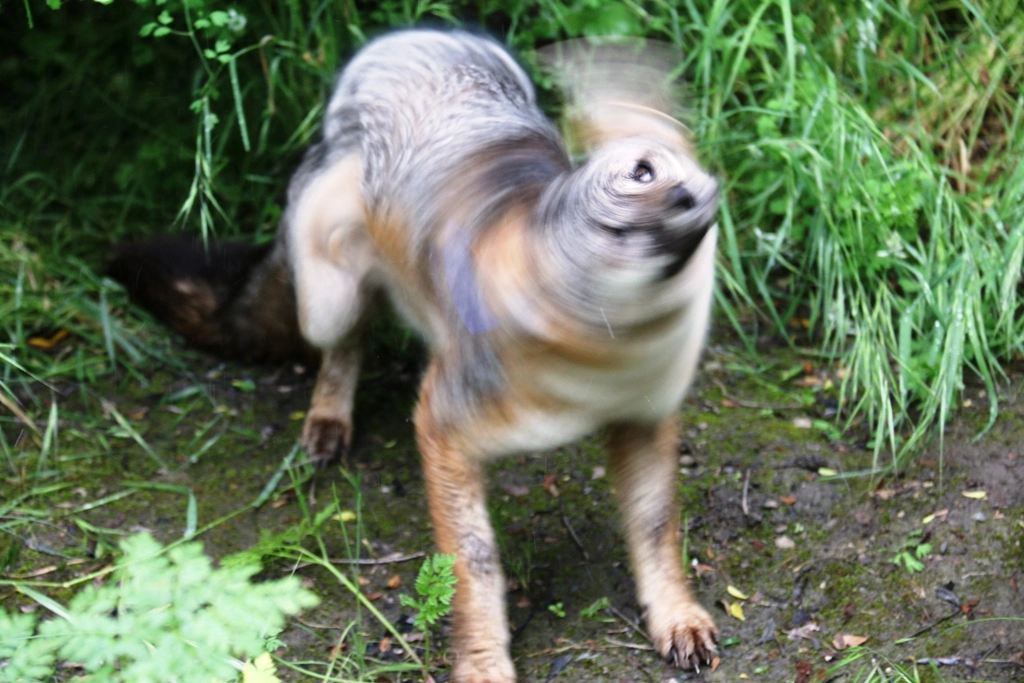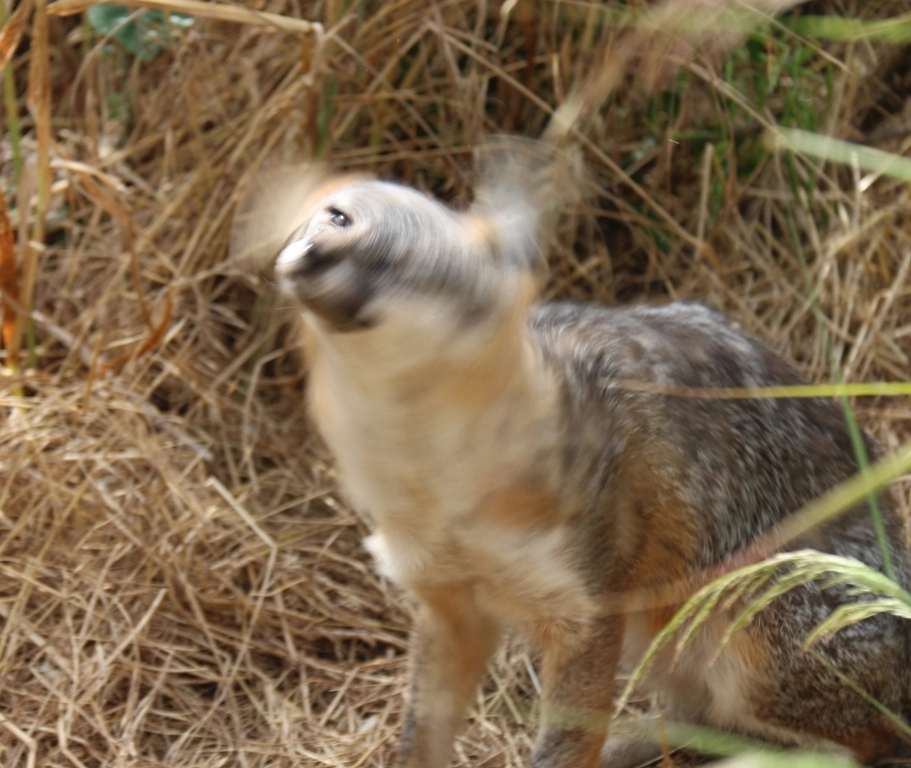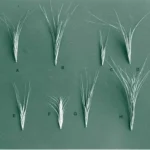Violent Head Shaking
by William C. Leikam
President, CEO & Co-founder, Urban Wildlife Research Project

Last month the Gray Fox Report was titled “Pups or Hormones?” As a follow up, all this past month I have been on the lookout for some indication that there were pups back in the woods. By this point in time, if there were any pups, they would be big enough to follow their parents around, going out with them at night to hunt and to learn the ways of becoming a successful gray fox. Once again, there are no pups at the baylands and Big Eyes hyper-skittishness that I mentioned last month has to be a result of her hormones.
As we monitor the gray fox pair and document their behavior, I am once again seeing something that has me perplexed and concerned. Laimos especially and most likely because I see him more often than Big Eyes, is once again violently shaking his head. When he does that, I can only think that whatever is in his ear(s) must be pretty irritating.
And then to complicate the matter, I checked back into my previous Gray Fox Reports and in the June and July 2020 edition of this report, I also note that the foxes are shaking their heads. This appears to be seasonal for here we are in June 2021. This does not happen during the remainder of the year.

After doing some online research I contacted Dr. Chad Alves, a wildlife veterinarian who I have worked with in the past. I asked him about this head shaking and he replied, “Bill, it could be a foreign body such as a foxtail or other plant awns (See Below). Might be some type of ear mite? We would need to look down there following some anesthesia. It’s the only way to properly diagnose their condition.” And in a follow-up email, Chad wrote, “Bill, if I get a chance to look in the ears hopefully it’s easy to treat. Ear mites would be treated with ivermectin/selamectin (See below). Foreign bodies have [to] be removed and depending on whether the tympanic membrane/ear drum is intact as to if they need additional treatment with antibiotics. Let me know if I can be of assistance?”
The sad part of all this is that we cannot live-trap Laimos to see what’s happening in his ears. That’s in part due to a lengthy review process prior to the issuance of a Scientific Collection Permit from the California Department of Fish & Wildlife. If this year the pattern holds to the same as last year and by July the head shaking stops, then we might have an annual malady in this gray fox.
 Selamectin: When used in dogs, parasites treated by selamectin include fleas, heartworms, ear mites, scabies, and certain ticks.
Selamectin: When used in dogs, parasites treated by selamectin include fleas, heartworms, ear mites, scabies, and certain ticks.
An awn is a hairy, or bristle-like, appendage growing from the ear or flower of barley, rye, and many types of widely growing grasses. (Source: https://www.petmd.com/dog/conditions/traumatic/can-grass-kill-your-dog)
Gray Foxes General Health
These two foxes appear to be in good health.
Total Numbers of Gray Foxes in the Palo Alto Baylands Nature Preserve
As of May, 2021, we have two adult gray foxes living in the Palo Alto Baylands Nature Preserve.
Section II
Update for the Urban Wildlife Research Project
The collaring project needs in excess of $35,000 and here’s the reason why you should consider a donation to UWRP be it $1 or $5,000 so that we can begin the collaring project dedicated to making the baylands along the San Francisco Bay a healthy place for wildlife to live. You can donate through PayPal or Give Direct, our preferred portal for giving. On our website (Urban Wildlife Research Project), check out the short video and go to the donate button nearby. Your donation is tax deductible.
Check out our Facebook page.
BE SURE TO Check out our YouTube Channel at https://www.youtube.com/channel/UC5ujc7p8dU1-O5AbPAWz2_Q
Undoubtedly the best Radio interview – KALW (Local PBS) Audio Recording Interviewed by Sofie Kodner during December 2020 – Broadcast 1/11/2021 5:00 PM on PBS’s program Crosscurrents https://www.kalw.org/post/bay-area-wildlife-habitats-are-disappearing-fox-guy-has-plan
Bill had a conversation with John Muir Laws and Marcia Sivek during a drawing workshop featuring the gray fox with the renowned artist John Muir Laws on January 14, 2021. It aired from noon until 1:30 PM. The Gray Fox: Art and Conservation • John Muir Laws
You can access Bill’s PowerPoint presentation Corridors & Connections: Sustaining the Health of All Wildlife presented during the October 24th P-22 Urban Wildlife Festival here: https://www.youtube.com/watch?v=Dh4MQL1D1Cc
NEW – To find out more about us, search Urban Wildlife Research Project, UWRP, gray foxes, wildlife connection, linkages, corridors and several documentaries and clips on https://www.youtube.com/channel/UC5ujc7p8dU1-O5AbPAWz2_Q
If you haven’t had a chance to read some of the articles that have been written about our study of gray fox behavior and our corridor work, click on these links as they will take you to the source: Bill Leikam – The Fox Guy, and Greg Kerekes & URWP
Section III
Gray Fox, Baylands Goals
Within the permit that allows the Urban Wildlife Research Project to conduct its study of the behavior of the gray fox at the Palo Alto Baylands Nature Preserve, the objectives covered area:
- Monitoring of urban gray fox Denning sites in Palo Alto Baylands.
This is being accomplished during the period when the gray foxes use a den site. It is one of the prime locations for gathering most of the behavioral data of the litter and for adults alike.
- Assessment of status and population trends of Baylands urban gray foxes
Since January 2019 a pair of resident gray foxes have claimed territory at the Palo Alto Baylands Nature Preserve.
- Identification of habitat features that promote the presence of urban gray foxes
After considering this and talking with people who know how to restore habitats, we need to assess what kinds of plants, including the Alkaline Salt Bush, would grow best along the edge of the saltwater channel and alongside the marsh. We need to grow a permanent habitat that contains the corridors and plant it as soon as possible. We’ll keep an eye on this as this is a critical link between the southern region of the Baylands and the northern region.
- Assessment of reproductive success and identification of factors that promote successful reproduction
Open up the pinch-point along Matadero Creek by developing thickets that link one area to another, instead of the present “islands”.
- Identification and assessment of possible dispersal travel routes.
Presently there can only be guesses as to dispersal travel routes. We intend to make this important question much more concrete when we attain our collaring/take/capture permit from the Department of Fish & Wildlife.



